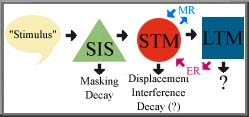
On to the experiments!

Scientists do not yet understand many things about human memory and
many of
the ideas and theories about it are still quite controvercial. The
following
discussion emphasizes some of the more widely agreed upon ideas. For
instance, most scientists agree that it is very useful to describe
human
memory as a set of STORES which are "places" to put information, plus
a set of
PROCESSES that that act on the stores.
A very simple model might contain 3 different stores:
The Sensory Information Store (SIS)
The Short-Term Store (STS)
The Long-Term Store (LTS)
... and 3 processes
Encoding (putting information into a store)
Maintenance (keeping it "alive")
Retrieval (finding encoded information)
A theory of human memory should not only identify a set of processes
and
stores, but also be able to help answer questions such how long it
will take
to retrieve accessible information and when information will be forgotten
(become inaccessible) To do this, the theory must specify properties
of the
processes and stores. For example, a store might have a "maximum capacity"
--- in other words, a maximum quantity of information that it can hold
at a
given time. If we know a store's capacity and what happens when that
capacity
is exceeded, we will be able to predict that certain information will
be
forgotten at certain times.
In the relatively simple model of memory presented here, sensory information
(from eyes, ears, etc..) enters the Sensory Information Store (SIS)
and is
either ignored or paid attention to. Ignored information doesn't last
very
long. New perceptual information quickly writes over (masks) the old,
a
process sometimes described as "interference." Attended information
is not
only protected from interference, it is processed by higher-level mechanisms
that figure out what it means. For instance, information in the SIS
might
indicate a bright red object somewhere ahead. Attending to this information
might reveal that there it is a stop-sign. Once information is processed
in
this way, it can be encoded into the short-term store (STS).
Usually, the STS is described as having a limited storage capacity (seven,
plus or minus two items) that "decay" and become inaccessible after
a
relatively brief interval (estimates range from 12 to 30 seconds). In
addition to decay, loss of information from the STS can occur by interference
when new information displaces older information. Interference does
not
always cause information to be lost, but may instead produce memory
retrieval
errors in which one recalls information that is similar to but not
identical
with that which is needed.
Information can be maintained in STM for releatively lon periods using
maintenance rehearsal (MR), a term describing the act of mentally (subvocally)
repeating the information to be maintained. In many cases, the reason
one
wishes to maintain information in the STS is to allow time for it to
be
encoded into the long-term store (LTS), and thus become more permanently
available. However, maintenance rehearsal does not appear to be very
efficient way to get the memory into long-term memory. Another memory
maintenance technique, elaboration rehearsal (ER) seems to work better.
Long-term memory can store a very large quantity of information and
can
maintain that information for very long periods of time. It holds
many
different kinds of information including: facts, events, motor and
perceptual
skills, knowledge of physical laws, spatial models of familiar environments,
attitudes and belifs about ourselves and others, etc. Many different
factors
seem to affect the difficulty of accessing a memory in the LTS. These
factors
include: the similarity between current conditions and those that existed
when
the memory was stored, how recently the memory was last used, its degree
of
inter-relatedness to other knowledge, its uniqueness relative to other
LTS
information, and so on. Much scientific research remains to be done
to
specify the effects of these factors in detail and to determine the
mechanisms
by which they produce their effects.
This graphic might help you visualize what you've leanred: